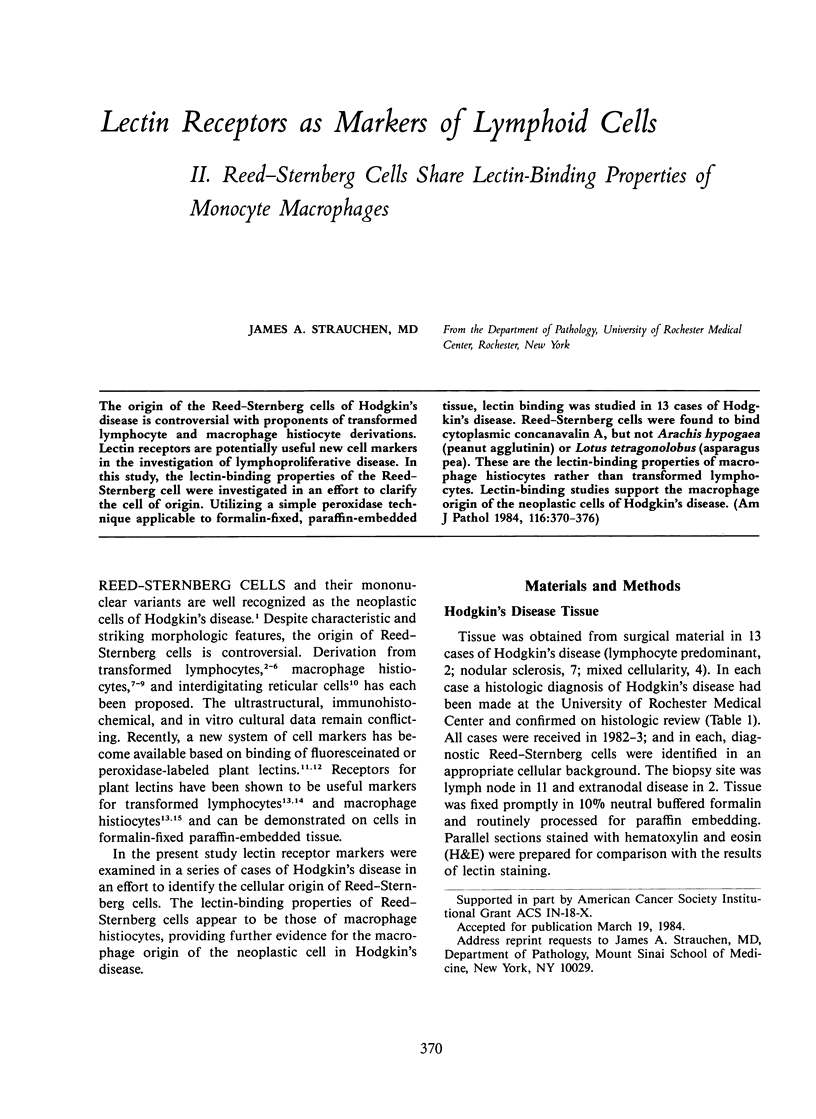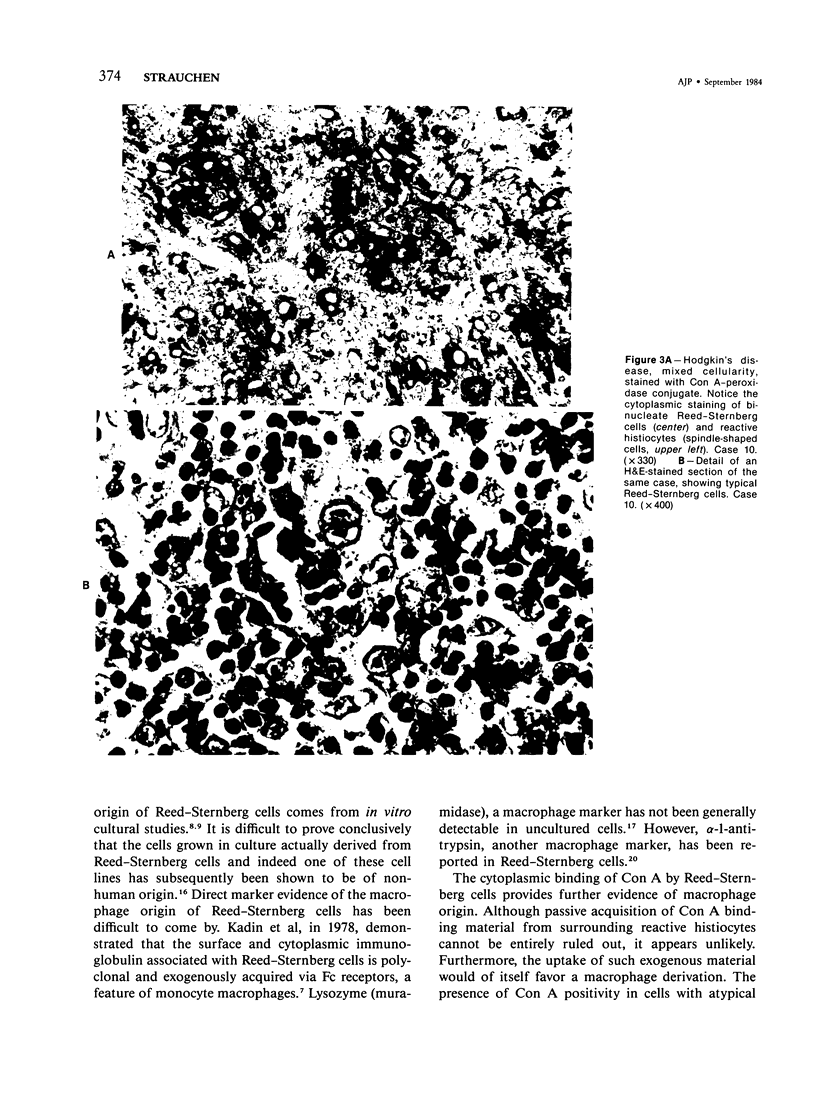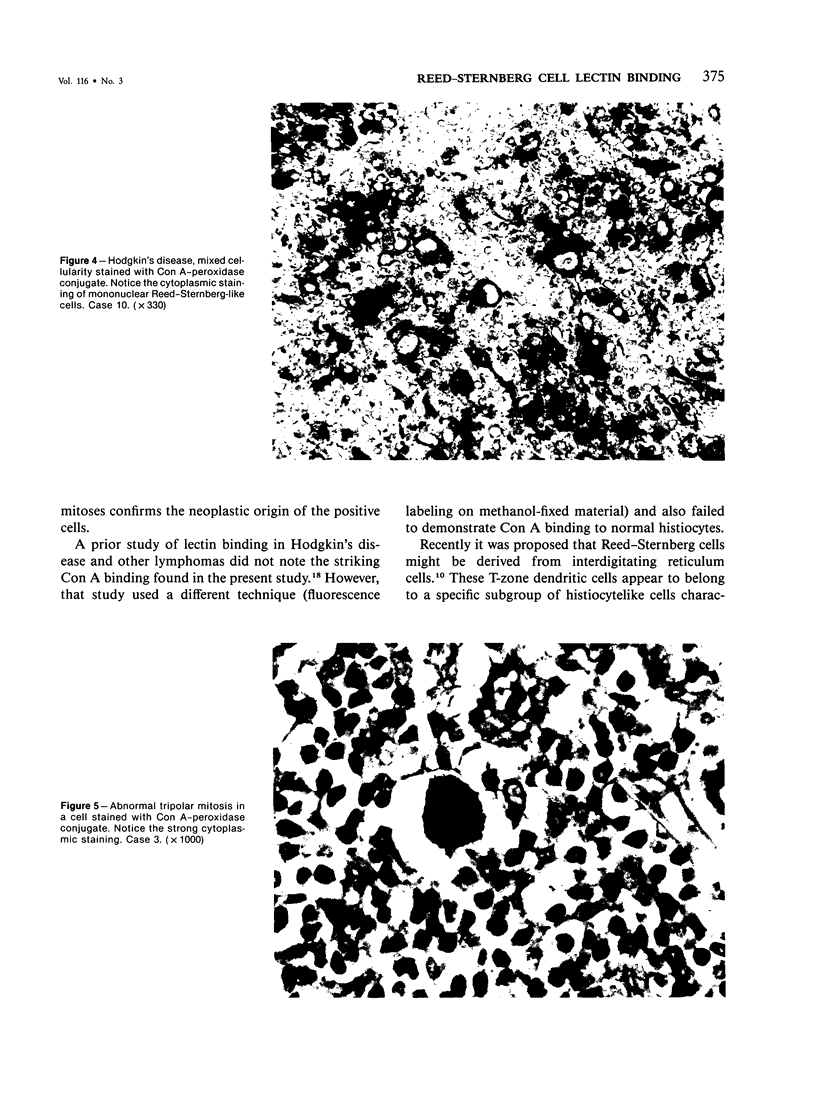Abstract
The origin of the Reed-Sternberg cells of Hodgkin's disease is controversial with proponents of transformed lymphocyte and macrophage histiocyte derivations. Lectin receptors are potentially useful new cell markers in the investigation of lymphoproliferative disease. In this study, the lectin-binding properties of the Reed-Sternberg cell were investigated in an effort to clarify the cell of origin. Utilizing a simple peroxidase technique applicable to formalin-fixed, paraffin-embedded tissue, lectin binding was studied in 13 cases of Hodgkin's disease. Reed-Sternberg cells were found to bind cytoplasmic concanavalin A, but not Arachis hypogaea (peanut agglutinin) or Lotus tetragonolobus (asparagus pea). These are the lectin-binding properties of macrophage histiocytes rather than transformed lymphocytes. Lectin-binding studies support the macrophage origin of the neoplastic cells of Hodgkin's disease.
Full text
PDF






Images in this article
Selected References
These references are in PubMed. This may not be the complete list of references from this article.
- Biniaminov M., Ramot B. Letter: Possible T-lymphocyte origin of Reed-Sternberg cells. Lancet. 1974 Mar 2;1(7853):368–368. doi: 10.1016/s0140-6736(74)93138-9. [DOI] [PubMed] [Google Scholar]
- Collins R. D., Jacobson W., Stoddart R. W. Lectin staining of carbohydrates of haemic cells. III. The cells of Hodgkin's disease and other lymphomas. Histopathology. 1982 Sep;6(5):601–616. doi: 10.1111/j.1365-2559.1982.tb02754.x. [DOI] [PubMed] [Google Scholar]
- Dorfman R. F., Rice D. F., Mitchell A. D., Kempson R. L., Levine G. Ultrastructural studies of Hodgkin's disease. Natl Cancer Inst Monogr. 1973 May;36:221–238. [PubMed] [Google Scholar]
- Garvin A. J., Spicer S. S., Parmley R. T., Munster A. M. Immunohistochemical demonstration of IgG in Reed-Sternberg and other cells in Hodgkin's disease. J Exp Med. 1974 May 1;139(5):1077–1083. doi: 10.1084/jem.139.5.1077. [DOI] [PMC free article] [PubMed] [Google Scholar]
- Glick A. D., Leech J. H., Flexner J. M., Collins R. D. Ultrastructural study of Reed-Sternberg cells. Comparison with transformed lymphocytes and histiocytes. Am J Pathol. 1976 Oct;85(1):195–208. [PMC free article] [PubMed] [Google Scholar]
- Harris N. L., Gang D. L., Quay S. C., Poppema S., Zamecnik P. C., Nelson-Rees W. A., O'Brien S. J. Contamination of Hodgkin's disease cell cultures. Nature. 1981 Jan 22;289(5795):228–230. doi: 10.1038/289228a0. [DOI] [PubMed] [Google Scholar]
- Kadin M. E. Possible origin of the Reed-Sternberg cell from an interdigitating reticulum cell. Cancer Treat Rep. 1982 Apr;66(4):601–608. [PubMed] [Google Scholar]
- Kadin M. E., Stites D. P., Levy R., Warnke R. Exogenous immunoglobulin and the macrophage origin of Reed-Sternberg cells in Hodgkin's disease. N Engl J Med. 1978 Nov 30;299(22):1208–1214. doi: 10.1056/NEJM197811302992203. [DOI] [PubMed] [Google Scholar]
- Kaplan H. S., Gartner S. "Sternberg-reed" giant cells of Hodgkin's Disease: cultivation in vitro, heterotransplantation, and characterization as neoplastic macrophages. Int J Cancer. 1977 Apr 15;19(4):511–525. doi: 10.1002/ijc.2910190412. [DOI] [PubMed] [Google Scholar]
- Leech J. Immunoglobulin-positive Reed Sternberg cells in Hodgkin's disease. Lancet. 1973 Aug 4;2(7823):265–266. doi: 10.1016/s0140-6736(73)93173-5. [DOI] [PubMed] [Google Scholar]
- Long J. C., Zamecnik P. C., Aisenberg A. C., Atkins L. Tissue culture studies in Hodgkin's disease: Morphologic, cytogenetic, cell surface, and enzymatic properties of cultures derived from splenic tumors. J Exp Med. 1977 Jun 1;145(6):1484–1500. doi: 10.1084/jem.145.6.1484. [DOI] [PMC free article] [PubMed] [Google Scholar]
- Payne S. V., Wright D. H., Jones K. J., Judd M. A. Macrophage origin of Reed-Sternberg cells: an immunohistochemical study. J Clin Pathol. 1982 Feb;35(2):159–166. doi: 10.1136/jcp.35.2.159. [DOI] [PMC free article] [PubMed] [Google Scholar]
- Ree H. J., Hsu S. M. Lectin histochemistry of malignant tumors. I. Peanut agglutinin (PNA) receptors in follicular lymphoma and follicular hyperplasia: an immunohistochemical study. Cancer. 1983 May 1;51(9):1631–1638. doi: 10.1002/1097-0142(19830501)51:9<1631::aid-cncr2820510914>3.0.co;2-p. [DOI] [PubMed] [Google Scholar]
- Ree H. J. Lectin histochemistry of malignant tumors. II. Concanavalin A: a new histochemical marker for macrophage-histiocytes in follicular lymphoma. Cancer. 1983 May 1;51(9):1639–1646. doi: 10.1002/1097-0142(19830501)51:9<1639::aid-cncr2820510915>3.0.co;2-z. [DOI] [PubMed] [Google Scholar]
- Ree H. J., Song J. Y., Leone L. A., Crowley J. P., Fanger H. Occurrence and patterns of muramidase containing cells in Hodgkin's disease, non-Hodgkin's lymphomas, and reactive hyperplasia. Hum Pathol. 1981 Jan;12(1):49–59. doi: 10.1016/s0046-8177(81)80241-9. [DOI] [PubMed] [Google Scholar]
- Sharon N., Lis H. Lectins: cell-agglutinating and sugar-specific proteins. Science. 1972 Sep 15;177(4053):949–959. doi: 10.1126/science.177.4053.949. [DOI] [PubMed] [Google Scholar]
- Strauchen J. A. Fluoresceinated lectins as probe for cell surface changes associated with lymphocyte transformation. Am J Hematol. 1982 May;12(3):227–232. doi: 10.1002/ajh.2830120304. [DOI] [PubMed] [Google Scholar]
- Strauchen J. A. Lectin receptors as markers of lymphoid cells. I. Demonstration in tissue section by peroxidase technique. Am J Pathol. 1984 Aug;116(2):297–304. [PMC free article] [PubMed] [Google Scholar]
- Watanabe S., Nakajima T., Shimosato Y., Sato Y., Shimizu K. Malignant histiocytosis and Letterer-Siwe disease. Neoplasms of T-zone histiocyte with S100 protein. Cancer. 1983 Apr 15;51(8):1412–1424. doi: 10.1002/1097-0142(19830415)51:8<1412::aid-cncr2820510815>3.0.co;2-l. [DOI] [PubMed] [Google Scholar]







